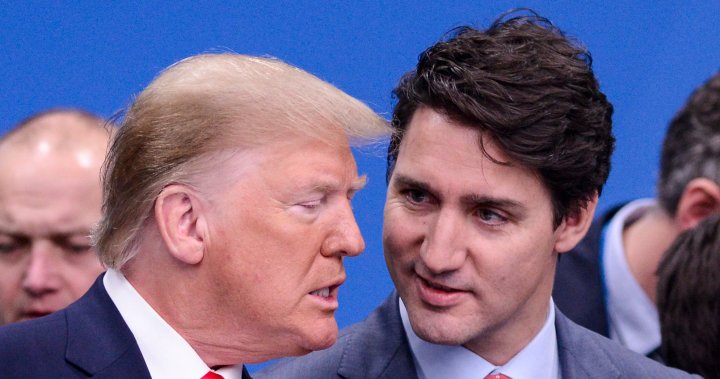U.S. president-elect Donald Trump on Monday proposed tariffs on all products coming into the United States from Canada and Mexico once he takes office.
It’s not the first time Canadians have had to deal with exports heading south of the border being taxed.
During his first term, Trump imposed a 20-per cent tariff on softwood lumber — part of the ongoing decades-old row over the product — followed a year later by a 25-per cent tariff on steel and 10-per cent tax on aluminum products.
Prior to taking office in 2016, Trump had blasted the North American Free Trade Agreement (NAFTA) and negotiations began in August 2017 when he was in the White House to carve out a new deal with Canada and Mexico, which remained underway by spring 2018 when Trump announced the tariffs on May 31, 2018.
Canada announced its own retaliatory tariffs on roughly $16.6 billion worth of steel, aluminum and hundreds of other products from the U.S., which also included things like maple syrup, shaving products, ketchup and even coffee.

By October 2018, a new NAFTA had been negotiated, the Canada-U.S.-Mexico-Agreement (CUSMA) — which the U.S. refers to as the USMCA — but it still took until May 2019 for an agreement to be reached to lift the tariffs on both sides.
That agreement officially took effect in July 2020 and was ratified after tariffs were lifted.
Prior to the deal, exports of steel and aluminum to the U.S. saw significant growth prior to the introduction of tariffs with steel up 22.6 per cent in the four months leading up to the imposition and aluminum rising 12.5 per cent from February to May of 2018.
According to Statistics Canada data, both then dropped once the tariffs were imposed, with steel declining by 37.8 per cent in June 2018 and aluminum seeing an average monthly export value during the tariff period at 18.6 per cent lower than in 2017.

Get daily National news
Get the day’s top news, political, economic, and current affairs headlines, delivered to your inbox once a day.
Imports of steel from the U.S. rose 31.3 per cent the month before Canada’s tariffs took effect, but fell 38.3 per cent a month later once the tax was in effect.
Trump then imposed another 10-per cent tariff on aluminum products from Canada in August 2020, only to back down a month later before Canada implemented their own retaliatory tariffs.
With more tariffs on the precipice with Trump set to take office in less than two months, Canadians may be wondering what tariffs could actually mean for them.
Trump has called “tariff” his favourite word, but what does it mean?
The simplest definition is effectively a tax that a country places on imports.
According to Export Development Canada, tariffs are a tax put on goods coming in from another country with the government collecting it like they would income or sales tax. Put simply, tariffs are a tax that make imported goods more expensive than those made at home.
For example, Canada sets a quota on the amount of cheese allowed to be imported from Europe. Any imports of European cheese that go beyond those quotas face a tariff of 245.5 per cent — making any such products considerably more expensive than buying a cheese that’s made here in Canada.
However, while tariffs may protect domestic industries, consumers can feel the pinch because they drive up the cost of importing into the country meaning higher costs at checkout.
They also give producers leeway to raise their own prices because they face less competition, meaning added costs for consumers at home.
In other words, Americans are expected to face higher prices on many products because of any tariffs that may be placed on imports by Trump.
Flavio Volpe, president of the Automotive Parts Manufacturers Association, told Global News one such example is cars as half the vehicles made in Canada are American companies, with half the components and raw materials used in manufacturing coming from the U.S.
“The reality is components and raw materials can cross the border up to seven times before they end up in a consumer’s hand as a car,” he said. “So if you’re going to tag that every time at 25 per cent, then no one’s going to buy it.”
Canadians could also feel impacts on several levels, with the potential decline to the Canadian dollar due to tariffs.

According to Tu Nguyen, an economist at RSM Canada LLP, when the Canadian dollar decreases in value the goods Canada imports become more expensive.
BMO senior economist Robert Kavcic noted in a statement that if the tariff threat were to impact energy exports — which accounted for Canada’s biggest share of goods to the U.S. as of September — the immediate result could be higher oil and consumer gas prices.
If Canada also implements retaliatory tariffs, Canadians could also pay more at stores because depending what is taxed, companies may have to pay more to produce their goods and in turn pass the buck onto consumers.
It’s yet to be seen if Canada will face the tariffs, as it’s only been proposed by Trump and Trudeau said he had a “good call” with the incoming president about the connections between their countries, and working on challenges.
In the meantime, however, Trudeau plans to hold a first ministers’ meeting with the country’s premiers this week to discuss next steps.
—with files from The Canadian Press, The Associated Press and Global News’ staff
© 2024 Global News, a division of Corus Entertainment Inc.





